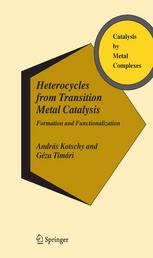

Most ebook files are in PDF format, so you can easily read them using various software such as Foxit Reader or directly on the Google Chrome browser.
Some ebook files are released by publishers in other formats such as .awz, .mobi, .epub, .fb2, etc. You may need to install specific software to read these formats on mobile/PC, such as Calibre.
Please read the tutorial at this link: https://ebookbell.com/faq
We offer FREE conversion to the popular formats you request; however, this may take some time. Therefore, right after payment, please email us, and we will try to provide the service as quickly as possible.
For some exceptional file formats or broken links (if any), please refrain from opening any disputes. Instead, email us first, and we will try to assist within a maximum of 6 hours.
EbookBell Team

4.0
56 reviewsHeterocycles from Transition Metal Catalysis: Formation and Functionalizationprovides a concise summary of the prominent role of late transition metal (palladium, nickel, copper) catalysed processes in the synthesis and functionalization of heterocyclic systems. It gives an introduction to catalytic transformations, an overview of the most important reaction types, and presents synthetically useful catalytic processes classified by the target system and the type of transformation.
The multitude and diversity of late transition metal (palladium, copper and nickel) catalysed reactions might seem daunting for the synthetic chemist, but this book converts anxiety to fascination by providing a well organised overview of the key catalytic transformations and their application in the preparation and functionalization of heteroaromatic systems. The demonstration that complex transformations, like a captivating toy, are made up by assembling the same "simple" building blocks, and a survey of the scope and limitations of these processes will help chemists to devise new, more efficient reactions and explain observations in academia and industry alike.
The book provides a representative selection of transition metal catalysed reactions, transformations that are relevant in heterocyclic chemistry. In this way, the authors provide a useful resource for members of the academic community looking for a textbook as well as industrial chemists in search of a reference book. This book is an invaluable resource for synthetic chemists, medicinal chemists, and those more generally interested in applied catalysis.